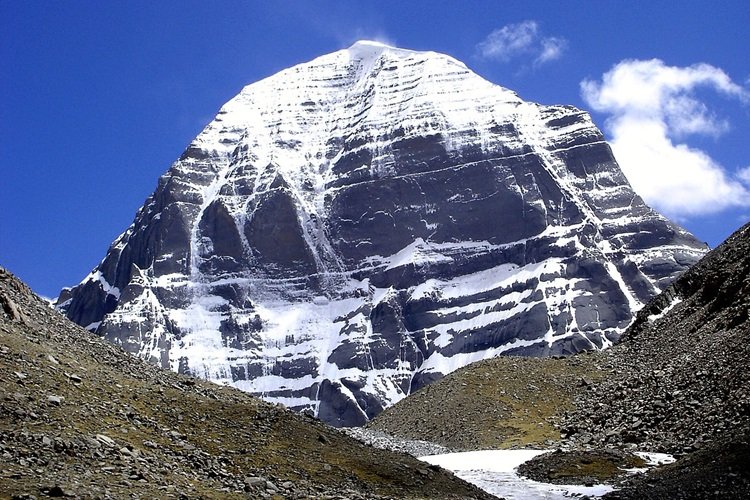The Mysteries of Mount Kailash: A Gateway to the Divine
Nestled amidst the rugged terrain of the Tibetan plateau, Mount Kailash stands as a towering enigma, captivating pilgrims, scientists, and adventurers alike. Revered as one of the most sacred mountains in the world, it transcends cultural boundaries, holding profound significance in Hinduism, Buddhism, Jainism, and the Bon tradition. Its unique pyramid-like structure, spiritual importance, and mysterious phenomena make Mount Kailash a topic of intrigue and reverence.
This article delves into the mysteries of Mount Kailash, real-life incidents associated with it, and its spiritual significance in India and beyond.
Geographical and Mystical Overview of Mount Kailash
Mount Kailash, part of the Trans-Himalayan range, rises to an altitude of 6,638 meters (21,778 feet). Unlike Everest or K2, which are climbers’ destinations, Mount Kailash remains unconquered—a sacred edict respected even by modern explorers. Its four faces align perfectly with cardinal directions, a phenomenon that continues to baffle geologists and scientists.
The mountain is the source of some of Asia’s most significant rivers: Indus, Sutlej, Brahmaputra, and Karnali (a tributary of the Ganges). Adding to its mystique is Lake Manasarovar, located nearby, believed to be the highest freshwater lake in the world and a reflection of cosmic harmony.
Spiritual Significance in Indian Religions
1. Hinduism: The Abode of Lord Shiva
In Hindu tradition, Mount Kailash is considered the abode of Lord Shiva and his consort, Goddess Parvati. Here, Shiva meditates in eternal stillness, symbolizing transcendence and liberation (moksha). Pilgrims undertake the arduous Kailash Mansarovar Yatra, a circumambulation of the mountain, known as parikrama, to cleanse their sins and attain spiritual enlightenment.
2. Buddhism: The Axis Mundi
For Tibetan Buddhists, Mount Kailash is believed to be the home of Demchok (Chakrasamvara), a deity symbolizing supreme bliss. The mountain is regarded as the Axis Mundi, or the cosmic axis, connecting Earth to heaven.
3. Jainism: The Site of Tirthankara Rishabhadeva’s Nirvana
Jains venerate Mount Kailash as Ashtapada, where Rishabhadeva, the first Tirthankara, attained moksha.
4. Bon Tradition: The Seat of Spiritual Power
The Bon religion, predating Buddhism in Tibet, identifies Mount Kailash as the site of the sacred city of Tagzig Olmo Lung Ring. It is revered as a source of spiritual power and cosmic energy.
The Mysteries and Myths Surrounding Mount Kailash
- The Unconquered Summit Despite multiple attempts, no climber has ever successfully scaled Mount Kailash. Even renowned mountaineers like Reinhold Messner have refrained, respecting its sanctity. A Chinese climber reportedly attempted to summit the peak in the 1980s but turned back after experiencing a series of inexplicable events.
- The Rapid Aging Phenomenon Several pilgrims and trekkers have reported unusually rapid aging near Mount Kailash. Hair and nails, which normally take weeks to grow, have been observed to grow significantly within a day in the vicinity, suggesting anomalies in time perception and biological processes.
- The Swastika Shadow A natural phenomenon occurs during certain times of the year when the mountain’s shadow forms a perfect swastika—a sacred symbol in Hinduism and Buddhism. This alignment fuels theories about the mountain’s geometric precision and mystical energy.
- The Inner Parikrama While the outer circumambulation is accessible to pilgrims, the inner parikrama remains off-limits to most, shrouded in myths about its supernatural dangers. Tibetan monks claim that only those with pure intent and advanced spiritual insight can safely traverse this path.
Real-Life Incidents and Testimonials
1. The Russian Expedition and Energy Phenomena
In 1999, a group of Russian scientists conducted studies on Mount Kailash. They proposed that it might be a man-made pyramid and the center of an ancient advanced civilization. They also reported experiencing intense energy vibrations near the mountain, which some linked to altered states of consciousness.
2. Swami Pranavananda’s Vision
Indian yogi Swami Pranavananda, who trekked to Mount Kailash in the 1930s, claimed to have seen the divine form of Lord Shiva during his parikrama. He described an overwhelming sense of bliss and timelessness, which he attributed to the mountain’s spiritual energy.
3. Mystical Experiences of Pilgrims
Many pilgrims recount experiences of divine visions, inexplicable light phenomena, and a sense of being watched. Some claim to have heard Om resonating naturally around the mountain, reinforcing beliefs about its divinity.
Scientific Perspectives on the Mysteries
While spirituality dominates narratives around Mount Kailash, scientists have also ventured into exploring its mysteries:
- Geological Anomalies: The mountain’s near-perfect symmetry and distinct striations have led some to speculate whether it’s a natural formation or a massive ancient structure.
- Magnetic Disturbances: Devices like compasses reportedly malfunction in its vicinity, pointing to powerful magnetic fields around the mountain.
These anomalies, combined with anecdotal evidence, hint at the presence of unexplored natural forces.
The Kailash Mansarovar Yatra: A Journey of Faith
For devout Hindus, the Kailash Mansarovar Yatra is a once-in-a-lifetime pilgrimage. The journey involves:
- A trek through rugged terrains across India, Nepal, and Tibet.
- A circumambulation of Mount Kailash, covering approximately 52 km (32 miles).
- A visit to Lake Manasarovar for ritual bathing, believed to cleanse lifetimes of sins.
Despite the physical hardships and high-altitude challenges, pilgrims often describe the yatra as a transformative spiritual experience.
Why Mount Kailash Remains an Eternal Mystery
Mount Kailash’s allure lies in its perfect blend of the spiritual and the scientific, the natural and the supernatural. Whether viewed as the dwelling place of gods or a geological wonder, it continues to inspire awe and devotion. Its mysteries remain unsolved, inviting seekers to reflect on the boundaries between faith and reason.
Conclusion
Mount Kailash is more than a mountain—it is a symbol of transcendence, unity, and the mysteries of the cosmos. For Indians and spiritual seekers worldwide, it represents the ultimate destination for those yearning to connect with the divine. Its untouched peak, mythical stories, and sacred geography ensure that its mysteries will endure for generations to come.
As science probes deeper and faith persists, Mount Kailash will remain a testament to humanity’s eternal quest for the unknown.
For the latest updates on News and Current Trends, follow us on X/Twitter here.
Infornex is now on every popular social media. Follow us on your favourite one to never miss an update, click here.
For more Breaking News and Updates, click here.

